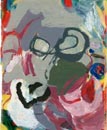
 |
 |
 |
 |
 |
 |
Picasso is said to have explained that he’d sometimes leave a painting unfinished and set the canvas aside in the corner of the studio. Weeks, months or even years later, he’d uncover that canvas to discover, lo and behold, it had magically resolved itself on its own.
Today’s post is an illustration of the point.
For more than a few years (I’d guess seven), the above paintings have been “flattening” between the pages of a hefty Random House dictionary in the corner of my studio. Each was housed there with the intention of continuing at some future moment. Yet, that moment never arrived. Upon discovering one after the other this week, I realized they had brought themselves to conclusion on their own.
The mechanism driving this bit of aesthetic alchemy is probably multifold. Even if they aren’t masterpieces, they do stand as unreproducible relics of a lost painter. The doors to that former self now closed, these works retroactively connect-the-dots to subsequent evolution.
Call it the aesthetics of compassion - increased self acceptance on the part of the painter leads to a tempering of the hypercritical eye. Could Picasso’s tale have been a wink and nod at the availability of maturation as another tool at the artist’s disposal?
Posted by mark at April 7, 2005 09:07 PMi enjoy visiting your site. best to both, john
Posted by: john miller at April 13, 2005 06:17 PMNice paintings.:)
I used to always feel that my work was 'not done'. So much so that people would ask me if I ever planned on finishing a painting. However, similiarly, I have feelings of acceptance and satisfaction about those works when I look back at them now. I think it may have to do with memories. Perhaps those pictures remind me of that time in my life, and so I feel that they express something honestly and thoroughly. But isn't it funny - like you said - that it feels like someone else painted them. Truly, we could never go back to where we were in those moments in the past. Almost like we're different people/artists.